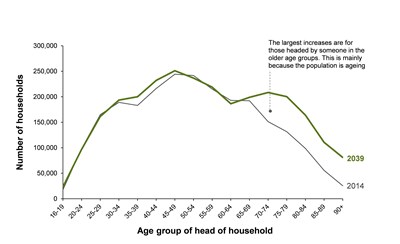Statistical News Release
Scotland’s household numbers projected to rise with most growth among older people
Statistics published today by the National Records of Scotland (NRS) show that the number of households in Scotland is projected to continue to increase, rising by 345,000 between 2014 and 2039.
The number of households headed by someone aged 70 or over is projected to increase by 65%, compared to an increase of just 2% for those under 70. Older people are more likely to live alone than younger people, and the number of people aged 70 and over living alone is projected to increase by 60% over the next 25 years, to 150,000 men and 260,000 women. The gender difference reflects women’s greater life expectancy and tendency to outlive their partners.
Tim Ellis, National Records of Scotland (NRS) Chief Executive and Registrar General, said:
“The figures published today by National Records of Scotland show a projected 345,000 extra households in Scotland in 2039 compared to 2014. This is partly because Scotland’s population is projected to increase in this period, but also because of our ageing population. Older people are more likely to live alone than younger people, and as more people live alone or in smaller households, the number of households will rise at a faster rate than the population.”
Projected number of households in Scotland by age of head of household, 2014 and 2039
Household numbers are projected to increase in almost every local authority area over the next 25 years. The largest projected increases are in Midlothian and the City of Edinburgh. Household numbers are projected to fall in just three local authority areas (Inverclyde, Argyll and Bute and Na h-Eileanan Siar).
The full publication ‘Household Projections for Scotland, 2014-based’, an infographic overview and interactive visualisations are available on the National Records of Scotland website.
Notes to editors
- These statistics are mainly used for informing decisions about housing need and service provision.
- The household projections are trend-based and are not, therefore, policy-based forecasts of what the Government expects to happen. Specifically, the assumptions do not take account of the recent referendum vote to leave the European Union.
- Further statistics produced by NRS, and information about our statistics, can be accessed at: https://www.nrscotland.gov.uk/statistics-and-data
There is a problem
Thanks for your feedback
